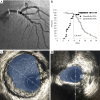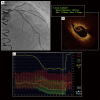The assessment of intermediate coronary lesions using intracoronary imaging
- PMID: 33224767
- PMCID: PMC7666953
- DOI: 10.21037/cdt-20-226
The assessment of intermediate coronary lesions using intracoronary imaging
Abstract
Intermediate coronary artery stenosis, defined as visual angiographic stenosis severity of between 30-70%, is present in up to one quarter of patients undergoing coronary angiography. Patients with this particular lesion subset represent a distinct clinical challenge, with operators often uncertain on the need for revascularization. Although international guidelines appropriately recommend physiological pressure-based assessment of these lesions utilizing either fractional flow reserve (FFR) or quantitative flow ratio (QFR), there are specific clinical scenarios and lesion subsets where the use of such indices may not be reliable. Intravascular imaging, mainly utilizing intravascular ultrasound (IVUS) and optical coherence tomography (OCT) represents an alternate and at times complementary diagnostic modality for the evaluation of intermediate coronary stenoses. Studies have attempted to validate these specific imaging measures with physiological markers of lesion-specific ischaemia with varied results. Intravascular imaging however also provides additional benefits that include portrayal of plaque morphology, guidance on stent implantation and sizing and may portend improved clinical outcomes. Looking forward, research in computational fluid dynamics now seeks to integrate both lesion-based physiology and anatomical assessment using intravascular imaging. This review will discuss the rationale and indications for the use of intravascular imaging assessment of intermediate lesions, while highlighting the current limitations and benefits to this approach.
Keywords: Optical coherence tomography (OCT); coronary artery disease (CAD); intravascular ultrasound (IVUS).
2020 Cardiovascular Diagnosis and Therapy. All rights reserved.
Conflict of interest statement
Conflicts of Interest: The authors have completed the ICMJE uniform disclosure form (available at http://dx.doi.org/10.21037/cdt-20-226). The series “Intracoronary Imaging” was commissioned by the editorial office without any funding or sponsorship. ATB reports other from Abbott Vascular, other from Boston Scientific, outside the submitted work. The authors have no other conflicts of interest to declare.
Figures




References
Publication types
LinkOut - more resources
Full Text Sources
Miscellaneous
